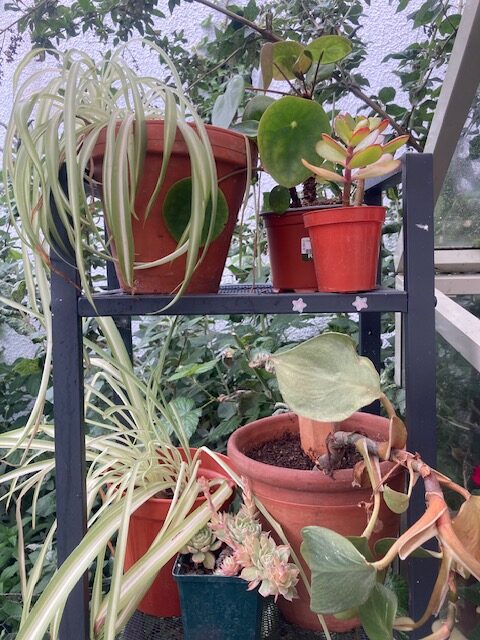The greenhouse has been pressed into unexpected service this week, as the annual houseplant holiday has hit a bit of a snag. Every winter my houseplants struggle with the low light and the dry centrally heated air, and by late spring they are look wan and drawn. And so every summer, when the weather turns warm, I put them outside. I put them just outside the back door, in a sheltered spot, some of them in sun but most of them in shade. And I know, I know never to trust a late April/early May heatwave, but wasn’t it seductive? I let the beginning of the month fool me with its balmy temperatures and yes, I put my houseplants outside too soon.
They could be moved back in, but I am reluctant to completely undo and redo any job, and so I have given them a temporary home in my mini greenhouse. Likewise I moved all of the tender plants out of this a week or so ago, and they now sit shivering on my patio, but there are levels of tender, and the houseplants need the space more.

Houseplants could easily spend their whole lives indoors – that’s generally the idea behind them – but I think there are a several benefits to the houseplant holiday. Firstly, they get greatly increased light exposure, which helps to green them up. Natural sunlight provides plants with the optimal light spectrum needed for photosynthesis, which promotes vigorous growth, richer foliage, and vibrant blooms. You have to be a little careful here though. Many houseplants originate on forest floors and were selected as houseplants precisely because they have such low needs for light. When moving them outdoors choose a shady spot, or you will burn their leaves.
The fresh air and air circulation certainly improves their health after a winter in closed rooms, and this strengthens the plant’s stems and improves overall resilience. It also reduces the risk of fungal infections and pest infestations that can occur in stagnant indoor environments. The flip side to this of course it that you do expose them to a range of pests and diseases outside that they wouldn’t be exposed to indoors, but just keep an eye on them so that you can take early action if anything attacks.
Rainwater is wonderful for houseplants. Over winter leaves can get dusty, which cuts down on the plant’s ability to photosynthesise. Putting them out in a rainstorm will wash them beautifully clean, and rainwater is often more beneficial for plants than tap water, as it is free from chemicals like chlorine and fluoride.
And then we come to the temperature fluctuations. There is something to be said for this. The natural fluctuation of outdoor temperatures can help toughen houseplants up a little. But late spring is a notoriously fickle time, weather wise, and alte frosts can still swing in as late as mid May. Too much temperature fluctuation is obviously a bad thing. No houseplant is frost hardy, and the slightest touch of frost will kill most if not all. Even low temperatures could really make them struggle.
And so I have moved them all into the mini greenhouse, just temporarily. There they can have the light they have been craving and some fresh air, but at night they can be a little more tucked away, and protected from the extremes of the temperature drop. My mini greenhouse is not heated, but just being able to close them in at night helps to keep the worst of the cool nights off.
With a little luck the next rise in temperatures will be a little longer lasting, and I can put my houseplants out for a long spell, and get them green, glossy and healthy for the summer.










